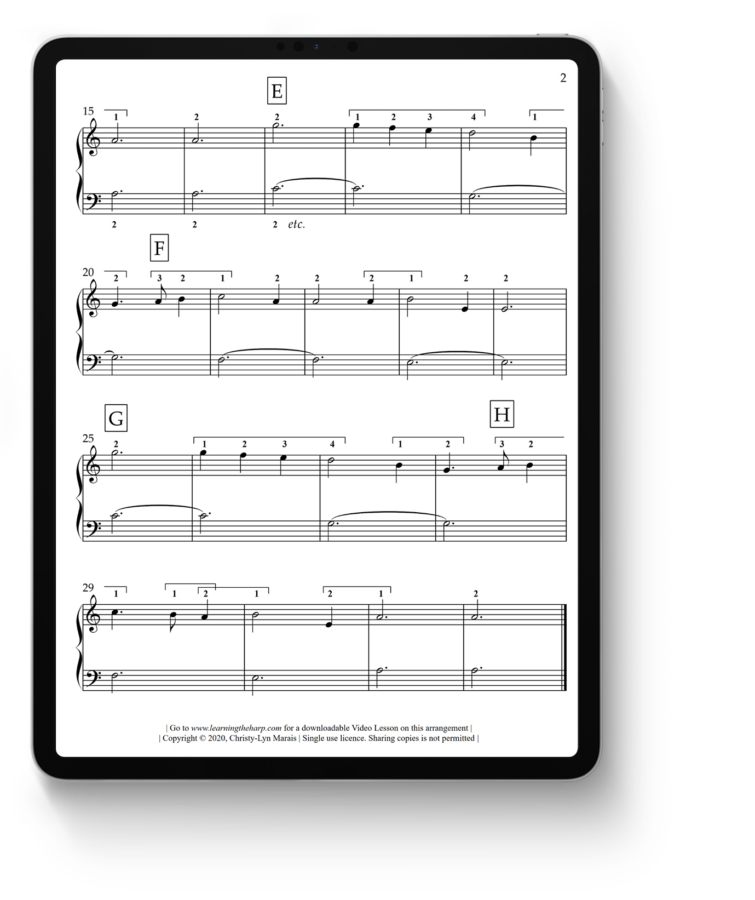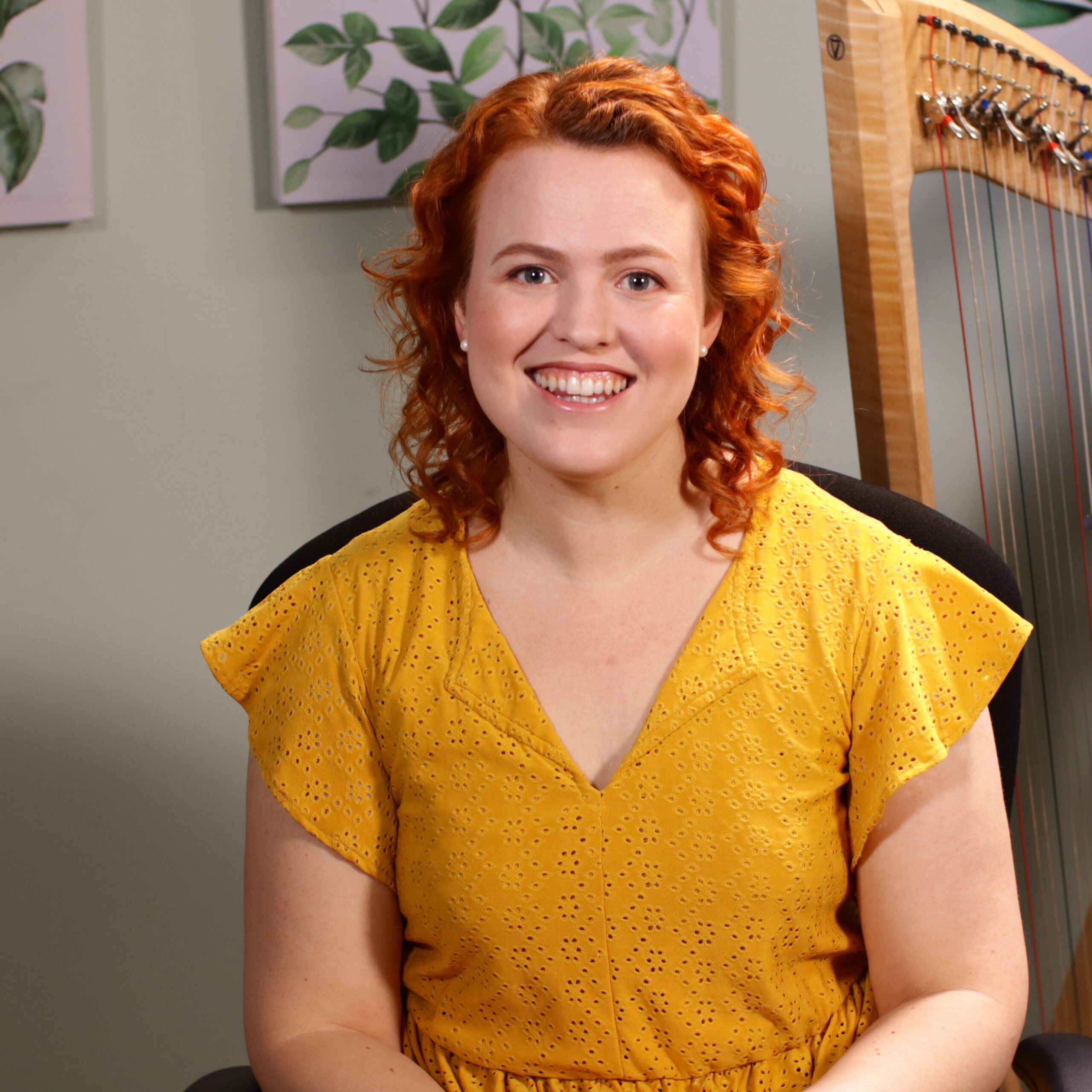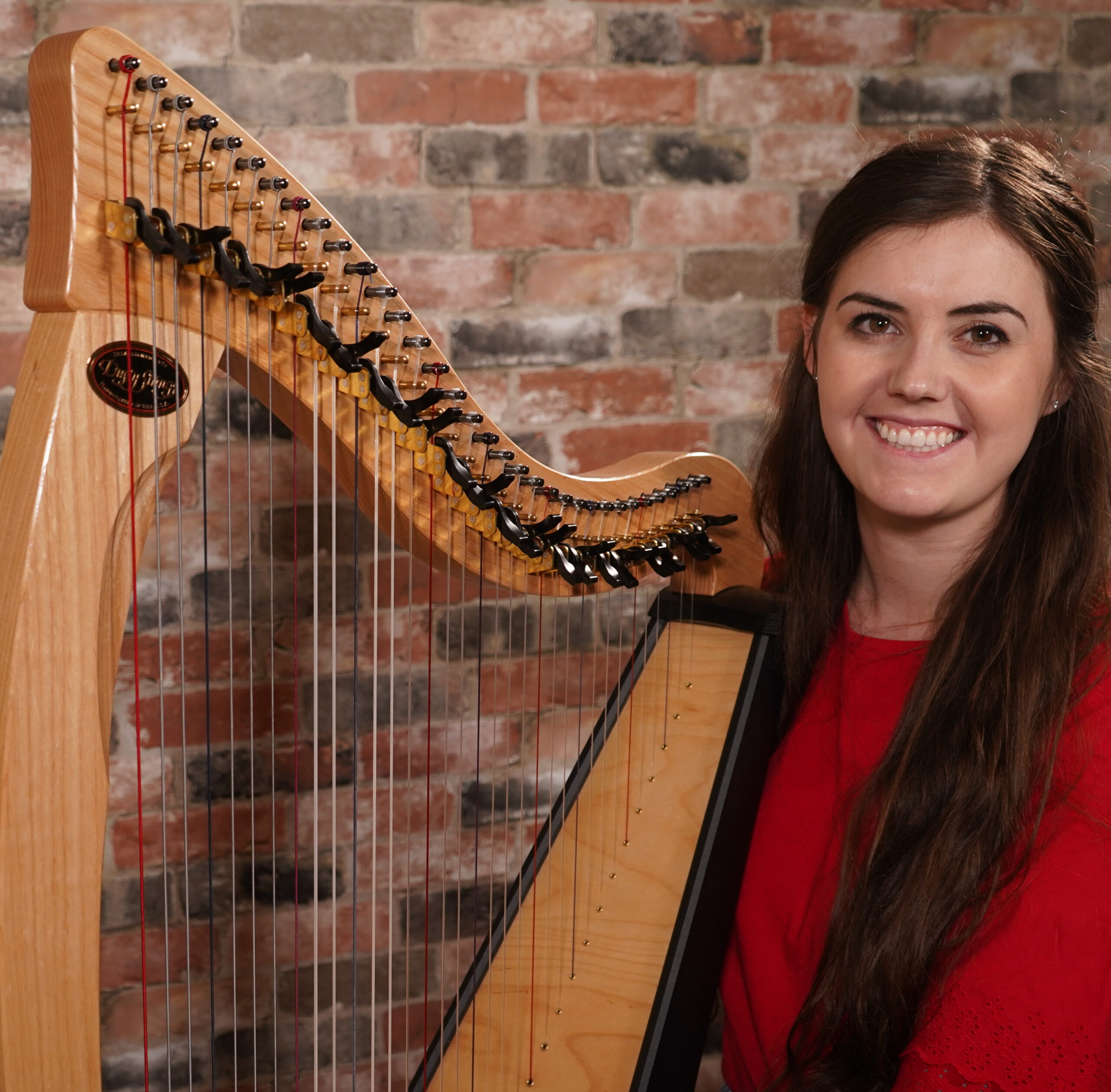Unlocking Sheet Music
Learn to read harp music fluently in 6 weeks
6-week program with Christy-Lyn and Carrie
Do you struggle with this?
You’re constantly stopping and starting because you can’t interpret the sheet music fast enough to play and read at the same time… it feels like your brain can’t keep up with your fingers!
You have to memorize every song to be able to play without stopping. But it’s slow to learn this way, and what if you forget? Your brain can only hold so many songs at once!
You lose your place in the music when you need to look at your hands. When you glance back at the sheet music, it feels like you’ve never seen the notes before!
Or you don’t know anything about sheet music and aren’t sure how to start with learning.

Will you be the next success story?

Lise Mayne

Emy Hoeg

Karen Ware
I struggled with learning to read sheet music too!
Christy-Lyn’s Story
I didn’t find it easy to learn to read sheet music. Honestly, it was something I was embarrassed about! I was taught mnemonics, like “Every good boy deserves fruit” and would use that to slowly figure out each note one-by-one. When my teacher asked me to play something new from sheet music, I felt an overwhelming sense of shame because I couldn’t actually identify each note. I remember trying to cheat by guessing what note to play next, and feeling like a terrible person because I should know this by now!
Over the next 10 years, I gradually got faster at reading sheet music, until I eventually got to the point where I could read sheet music quickly. It’s been such a relief and allowed me to explore so much more music! But I wish the process had been easier and hadn’t taken so many years to learn.
When it came to my harp students learning to read sheet music, I saw them having the same frustrations as I had in my early days, and trying different coping mechanisms like writing the letter names under each note. I realized I had to figure out a better way to help them get results faster than I did!
That’s when I started the process of creating the Fluent Formula. I’ve spent years refining these methods, and I’m so excited to share them with you! I really believe it will help you to skip the frustration and learn to read sheet music more easily.
When it came to my harp students learning to read sheet music, I saw them having the same frustrations as I had in my early days, and trying different coping mechanisms like writing the letter names under each note. I realized I had to figure out a better way to help them get results faster than I did!
That’s when I started the process of creating the Fluent Formula. I’ve spent years refining these methods, and I’m so excited to share them with you! I really believe it will help you to skip the frustration and learn to read sheet music more easily.
Carrie’s Story
When I started learning the harp as a child, I did not know how to read music. I learned primarily by ear, and it wasn’t until 5-6 years into playing that I really started to feel comfortable reading music. If you look back through my sheet music from those early years, you’ll see every note name written above each note! Come to find out, that was actually hindering my progress more than helping.
I remember my struggle with reading music caused a lot of shame and discouragement. I LOVED playing the harp, but I felt like my pace in reading music was really slowing me down. I thought I had been playing for long enough that I should just “get it”, and I wondered if it would always be this difficult.
I remember getting so frustrated at one point that I considered quitting the harp! But I’m so glad I stuck with it, because it was very freeing and empowering to accomplish something that had been holding me back for years. And it gave me a deeper appreciation and understanding of music as a whole!
There wasn’t a point in my learning where it one day all just clicked and I was suddenly fluent. It was very much a gradual process of recognizing intervals and the relationship between notes, and lots and lots of practice. Looking back to my early years of learning the harp, I was never really taught an effective strategy for reading music and I know that would’ve been SO helpful.
Reading music doesn’t have to be something you just gradually pick up after years of playing. It really is it’s own language that can be learned with intentionality and a clear path forward, and that’s what you’ll find in this program.
There wasn’t a point in my learning where it one day all just clicked and I was suddenly fluent. It was very much a gradual process of recognizing intervals and the relationship between notes, and lots and lots of practice. Looking back to my early years of learning the harp, I was never really taught an effective strategy for reading music and I know that would’ve been SO helpful.
Reading music doesn’t have to be something you just gradually pick up after years of playing. It really is it’s own language that can be learned with intentionality and a clear path forward, and that’s what you’ll find in this program.
The Fluent Formula:
The secret to reading fast, without thinking hard
A Ground-Breaking 4-Part System
Create a strong page-to-finger connection
To read sheet music fluently, you need to see a note and immediately be able to play it, without stopping to figure out what it is. When you focus on naming the notes, it creates a ‘traffic jam’ in your head, which interrupts the page-to-fingers flow. Instead, learn how to play notes based on the geography of your harp. This will speed up the page-to-fingers connection so that you instantly know where your fingers must go.
Read whole ‘words’ and ‘sentences’ instead of individual ‘letters’
Instead of seeing music as a whole lot of disconnected notes, you’ll learn to identify the ‘words’ and ‘sentences’ in music – shapes and patterns of notes. Learn how to follow the notes as they go up and down on the page and mimic this on your harp, so that you don’t have to stop and figure out each individual note. It’s like being able to read the word “dog” instead of still having to spell out “D.O.G” before you can figure out the word.
Feel the rhythm in your bones!
Counting out each beat at the same time as you’re playing can be very confusing. Instead, you’ll learn to feel the beat like a heartbeat, which stays constant and doesn’t stop. You’ll learn each type of note and will practice how long to hold each note based on it’s time value

Learn each new song with sheet music fluency in mind
When you practice playing a new song, you’re also by default practicing where to look with your eyes… and if you don’t practice keeping track of the sheet music, you’ll never feel comfortable reading along! You need to have a sheet music fluency plan so that as you practice your song you’re also practicing good habits of sheet music reading. Then once a song is ready to play fluently, you’ll be able to read along fluently as well.
Once you have learned all 4 of these elements, you’ll be free of the stress of desperately trying to interpret a page full of notes. By helping you make sense of what’s on the page, you’ll be able to master sheet music rather than feeling overwhelmed.
What our students say

My whole life I’ve never understood any of it, and now it’s just making sense! I actually tried some music the other day that I didn’t know, and I could actually read it! I just couldn’t believe it!
Cherie Maffey

Despite my knowledge of sight-reading for violin, chords and stacked notes are totally foreign to me. So I found it this invaluable, even for an experienced musician. This course was very helpful and I learned so much!
Diane MacIntyre

I’ve finally become friends with my left hand! Learning this way is just so fun and lovely, and it’s not high pressure, there’s no guilt in getting things incorrect. I used to just freak out when I saw a clump of dots, and now I unravel it so much easier, so thank you so much!
Rosemarie Fortney
PRODUCTS
PRODUCTS
EXPLORE
CONTACT
©️2023 – Learning the Harp

